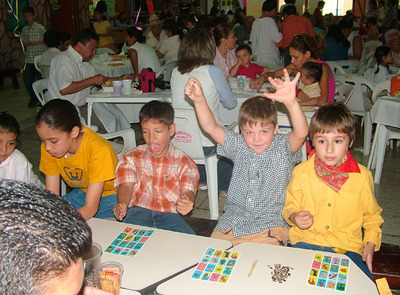
Mexican schools will welcome you as a foreigner – to a certain extent.
Your kids have had a blast in Mexico. You have as well. They’re sold, you’re sold. Everyone is caught up in hyper-speed towards relocation until you realize… yikes! It is time to pull back on the south-bound, super-shuttle throttle – your children have to go to school.
You have three basic options for schooling your child in Mexico (on the mainland or on the Baja California Peninsula): public school, private school or homeschooling. My personal advice, based upon experience with both private and public school systems on the mainland and in Baja, is this – if your child is bilingual, and speaks Spanish fluently, you have any school in the country available to you, pick and choose.
If your child is not bilingual, and has little familiarity with the Spanish language, tread cautiously. A private school may best suit his or her needs, where Spanish is taught for half the day and English the other half. For the English-learning part of the day they get to be the star student, counter-balancing the initial struggles and frustrations during the hours of Spanish instruction.
In immersion programs, the instructors are trained to deal with issues faced by non-native speakers. They have to be to teach Mexican children English. In public schools, they most likely are not. The cost of private schooling runs anywhere from $150 to $350 USD a month and up. In addition to this monthly tuition, you will have an annual enrollment fee plus school uniform and book expenditures.
Mexican schools will welcome you as a foreigner – to a certain extent. In deciding what option may be best for your child, keep in mind that public schools in Mexico will not provide support for a non-native speaking child, as is common in many areas of the U.S. and other First World countries. Your advantaged and/or bright child may succeed effortlessly from the ages of three to seven years of age (approximately) when language acquisition is at its peak and little academic stress is put upon them.
Your middle school-aged child or teenager may or may not. A less-stressful first leap into the culture may be a summer program or volunteer abroad program. There are summer programs in Baja and on the mainland.
Another alternative is to start out homeschooling and take it from there, making decisions based on how it goes and what resources are available in your particular city or town. Some expat American and Canadian parents send their children to the local public program in the day or afternoon and home-school English curriculum.
Enrolling a Child in School
To enroll a child in public or private school in Mexico, you must show proof he or she has successfully completed the previous school year and therefore is eligible to continue on to the next grade level. If there are no school records available, or the student does not pass final examinations, they have to repeat the previous year. In my son’s fourth grade public school class, one child was 12 years old.
The school will ask for a copy of the child’s birth certificate, a copy of school records showing completion of the previous year of study and photo identification for the child and for the parent. If your child has been homeschooling in the states independently of any school system, you must create an official report for him or her that is validated in a way acceptable to the school.
Mexican public school hours are typically from 8 a.m. to 1:00 p.m. Private school hours commonly follow the North American norm of 8 a.m. to 2:30 p.m. Private schools have independent control over curriculum and hours of operation ,but must adhere to the same government-mandated guidelines for enrollment.
Cultural Issues and Helping Children Adjust
Childhood rejection comes in bits and bursts, and is a normal part of growing up for any child in any culture. For an American or Canadian child in Mexico however, rejection can come unexpectedly in mad rushes and devastating throngs. The peer group depended upon for social acceptance and survival is foreign in origin, and most often non-English speaking. No matter the age of your child or children, if you are a North American living in Mexico, assimilation into the culture is a non-issue. Your survival as an expat family, and your child’s emotional health, depends upon it.
Not being familiar with the Spanish language is not an insurmountable roadblock. It can actually work in your favor! Being a newbie is advantageous in that you will be viewing the culture fresh, learning the local dialect as a matter of course, and will elicit all kinds of assistance from helpful folks when shopping, setting up a bank account, etc.
At the same time, you will get a feel for the local culture – how many Mexicans speak some English (many fluently), and for how gracious, kind and helpful most native Mexican people are. They try hard to understand us foreigners and to communicate, ignoring how we often, unintentionally, butcher their lovely language when attempting to speak Spanish.
So if you are clueless to the language other than “dónde está el baño” and “otra cerveza, por favor” and/or your child or children have never taken a foreign language course in their young lives, don’t be discouraged. You and your children will have many challenging moments in the beginning, and a rudimentary grasp of language skills will be necessary in the long-run for survival, but it is not an insurmountable obstacle.
As you and your family grasp the basics, and are able to integrate with Mexican families in your community, life will normalize. Soon Mexico may feel more like home than a foreign land you escaped to.


We are planning to move to Veracruz Mexico in the next few years i will have a 12 year old 10 year old 9 year old 7 year old and 4 year old. 2 are half Hispanic. But I was curious to what I need to put them in school.
I think you would are likely to get a faster response by posting this query on one of the FB groups devoted to expats in Mexico. eg https://www.facebook.com/groups/1978054259090741/
My grandson’s mother wants to take my 8 year old grandson to Mexico for 2 years. I worry because he does not speak Spanish. He is third grade and reading on a first grade level in English. How would he fare in a school in Mexico?
Hi,there
I have one boy,12,I think to send him go México school to study, do you know where the school with IB program sice secondery school (middle school).I perfecto to have english and spanish program together.
Here is a list of IB World Schools offering the IB Middle Years program – https://www.ibo.org/programmes/find-an-ib-school/?SearchFields.Region=iba&SearchFields.Country=MX&SearchFields.Keywords=&SearchFields.Language=&SearchFields.BoardingFacilities=&SearchFields.SchoolGender=&SearchFields.ProgrammeMYP=true